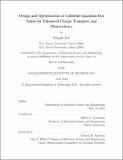| dc.contributor.advisor | Jeffrey C. Grossman. | en_US |
| dc.contributor.author | Lee, Sangjin, Ph. D. Massachusetts Institute of Technology | en_US |
| dc.contributor.other | Massachusetts Institute of Technology. Department of Materials Science and Engineering. | en_US |
| dc.date.accessioned | 2016-09-13T18:10:34Z | |
| dc.date.available | 2016-09-13T18:10:34Z | |
| dc.date.copyright | 2016 | en_US |
| dc.date.issued | 2016 | en_US |
| dc.identifier.uri | http://hdl.handle.net/1721.1/104152 | |
| dc.description | Thesis: Ph. D., Massachusetts Institute of Technology, Department of Materials Science and Engineering, 2016. | en_US |
| dc.description | This electronic version was submitted by the student author. The certified thesis is available in the Institute Archives and Special Collections. | en_US |
| dc.description | Cataloged from student-submitted PDF version of thesis. | en_US |
| dc.description | Includes bibliographical references (pages 93-102). | en_US |
| dc.description.abstract | Colloidal quantum dots (CQDs) have attracted much attention due to their distinctive optical properties such as wide spectral responses and tunable absorption spectra with simple size control. These properties, together with the advantages of solution processing and superior robustness to organic materials, have motivated the recent investigation of CQD-based solar cells, which have seen rapid growth in power conversion efficiency in just the last 10 years, to a current record of over 10%. However, in order to continue to push the efficiencies higher, a better understanding of the charge transport phenomena in CQD films is needed. While the carrier transport mechanisms between isolated molecules have been explored theoretically and the device-scale mobility of CQD layers has been characterized using experimental measurements such as time-of-flight analysis and field-effect-transistor measurements, a systematic study of the connection between these two distinct scales is required in order to provide crucial information regarding how CQD layers with higher charge carrier mobility can be achieved. While a few strategies such as ligand exchanges, band-like transport, and trap-state-mediated transport have been suggested to enhance the charge carrier mobility, inhomogeneity in CQD solids has been considered a source of the mobility degradation because the electronic properties in individual CQDs may have dispersions introduced in the synthesis and/or in the deposition process, leading to the deviations of the localized energy states from the regular positions or the average energy levels. Here, we suggest that control over such design factors in CQD solids can provide important pathways for improvements in device efficiencies as well as the charge carrier mobility. In particular, we have focused on the polydispersity in CQDs, which normally lies in the range of 5-15%. The effect of size-dispersion in CQD solids on the charge carrier mobility was computed using charge hopping transport models. The experimental film deposition processes were replicated using a molecular dynamics simulation where the equilibrium positions of CQDs with a given radii distribution were determined under a granular potential. The radii and positions of the CQDs were then used in the charge hopping transport simulator where the carrier mobility was estimated. We observed large decreases (up to 70%) in electron mobility for typical experimental polydispersity (about 10%) in CQD films. These large degradations in hopping charge transport were investigated using transport vector analysis with which we suggested that the site energy differences raised the portion of the off-axis rate of charge transport to the electric field direction. Furthermore, we have shown that controlling the size distribution remarkably impacts the charge carrier mobility and we suggested that tailored and potentially experimentally achievable re-arrangement of the CQD size ensemble can mediate the mobility drops even in highly dispersive cases, and presents an avenue towards improved charge transport. We then studied the degradation in CQD solar cells with respect to the polydispersity and how these enhanced charge transport from re-design of CQD solids can boost the photovoltaic performances. In addition, we estimated the potential in the binary CQD solids in terms of their improved charge transport and efficient light absorption. Combined with the accurate size-dependent optical absorption model for CQDs, our hopping model confirmed that the inclusion of smaller CQDs could enhance both the charge transport and the solar light absorption, leading to the enhanced average charge generation rates and solar cell performance. | en_US |
| dc.description.statementofresponsibility | by Sangjin Lee. | en_US |
| dc.format.extent | pages | en_US |
| dc.language.iso | eng | en_US |
| dc.publisher | Massachusetts Institute of Technology | en_US |
| dc.rights | M.I.T. theses are protected by copyright. They may be viewed from this source for any purpose, but reproduction or distribution in any format is prohibited without written permission. See provided URL for inquiries about permission. | en_US |
| dc.rights.uri | http://dspace.mit.edu/handle/1721.1/7582 | en_US |
| dc.subject | Materials Science and Engineering. | en_US |
| dc.title | Design and optimization of colloidal quantum dot solids for enhanced charge transport and photovoltaics | en_US |
| dc.title.alternative | Design and optimization of CQD solids for enhanced charge transport and photovoltaics | en_US |
| dc.type | Thesis | en_US |
| dc.description.degree | Ph. D. | en_US |
| dc.contributor.department | Massachusetts Institute of Technology. Department of Materials Science and Engineering | |
| dc.identifier.oclc | 958279428 | en_US |
